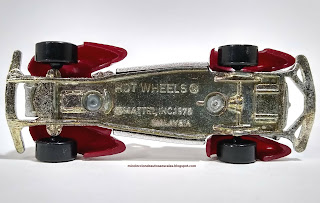The Mercedes-Benz 500K (W29) is a grand touring car built by Mercedes-Benz between 1934 and 1936. First exhibited at the 1934 Berlin Motor Show, it carried the factory designation W29. Distinguished from the 500 sedan by the "K" for Kompressor (German for supercharger), only fitted to these performance cars, it succeeded the Mercedes-Benz 380 introduced just the previous year. It offered both a larger, more powerful engine and more opulent coachwork to meet customers' demands for greater luxury and performance.
Este es un blog de fotografías para la colección personal de autos de diferentes escalas.
Wednesday, August 28, 2024
1935 Mercedes Benz 500K Special Roadster 1:24
The Mercedes-Benz 500K (W29) is a grand touring car built by Mercedes-Benz between 1934 and 1936. First exhibited at the 1934 Berlin Motor Show, it carried the factory designation W29. Distinguished from the 500 sedan by the "K" for Kompressor (German for supercharger), only fitted to these performance cars, it succeeded the Mercedes-Benz 380 introduced just the previous year. It offered both a larger, more powerful engine and more opulent coachwork to meet customers' demands for greater luxury and performance.
Thursday, July 7, 2016
1935 Cadillac Hot Wheels 1:64 The '35 Classic Caddy
From Fandom:
The '35 Classic Caddy is a Hot Wheels licensed model designed by Larry Wood. It is modeled after the Cadillac Series 355. The Cadillac Series 355 was manufactured by Cadillac from 1931 to 1935. They were 8-cylinder cars, sold in several models: a 2-door club coupe, a 2-door convertible, 4-door convertible, a 4-door sedan a 4-door town car and a 4-door limousine
The 1935 Model 355E was divided into three series, the Series 10, 20 and 30. Bodies on the Series 10 and 20 were built by coachbuilder Fisher and on the Series 30 by coachbuilder Fleetwood. Styling emphasized streamlining, including concealment of all chassis features except the wheels. Body construction was improved for better insulation against engine heat and reduction of engine, road and wind noise. The grille was V-shaped and sloping, set into a painted shell. Although restricted use of chrome was a feature of the overall ornamentation, a chrome plated radiator shell was available as an option. Horns and radiator filler cap were concealed under the hood. Teardrop Guide Multibeam headlights were mounted on streamlined supports attached to the fenders. Parking lamps were mounted on the headlight supports. Airfoil shaped fenders were brought low over the chassis. The hood sills were high with the entire fender shape molded into the radiator shell. A curious horizontal crease broke the nose contour of the fenders. Hoods extending nearly to the windshield carried shutter-type louvers in the side panel.
The diecast model features two spare tires with covers, an open driver's compartment and an enclosed passenger compartment. The model has the distinct grille and hood louvers.
Saturday, April 28, 2012
1935 Duesenberg SSJ 1:24 Danbury Mint
El Duesenberg J fue uno de los automóviles más exclusivos que se construyeron no sólo en los Estados Unidos, sino en el mundo entero. El Duesenberg J (en sus diversas versiones) representó el poder y la opulencia característicos de las épocas de bonanza de la Norteamérica de los 1920, soportando la Gran Depresión gracias a los multimillonarios y actores de Hollywood, sus principales compradores. Entre los más notables usuarios estaban Clark Gable y Gary Cooper personajes que elevaron al J como un auto legendario.
Este automóvil superó la crisis económica al lograr que su reducida producción se extendiera hasta 1937, nueve años después de su lanzamiento, sin que su coste de 20 000 USD, alto para la época, fuera un impedimento. Con un motor de 6,9 litros y 198 kW (269 cv) a 4200 rpm, era capaz de alcanzar hasta los 200 km/h. 378 de los 481 Duesenberg J construidos todavía existen, siendo uno de los coches más buscados y valiosos para los coleccionistas, que son capaces de ofrecer extraordinarias cantidades por tener una de estas obras de arte.
Alfonso XIII usó un vehículo de este modelo para desplazarse de Madrid a Cartagena, la noche del 14 al 15 de abril de 1931, cuando salía al exilio.Thursday, August 14, 2008
1935 Auburn 852 Boattail Hot Wheels 1:64
From Wikipedia:










































